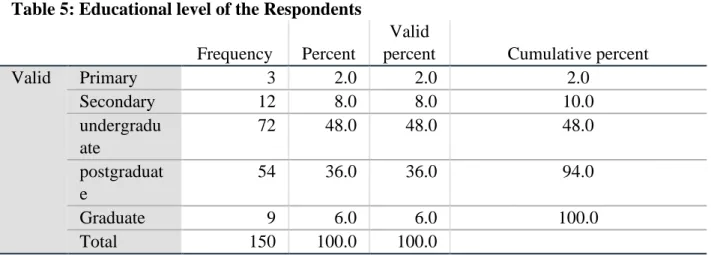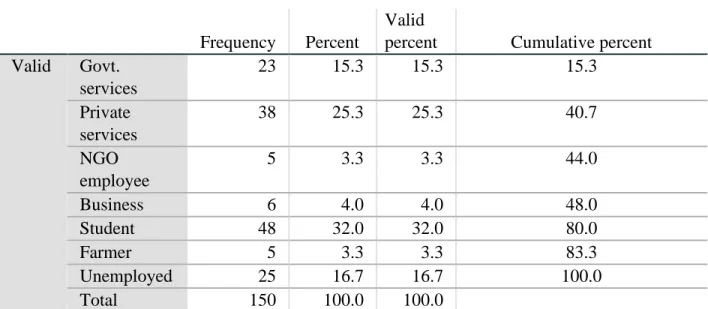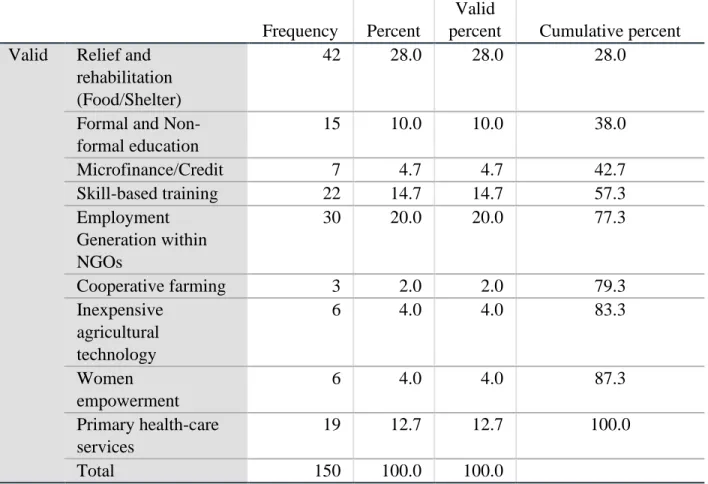Thirdly, we would like to thank the Honorable Dean of FHSS, Head of the Department, all the respected faculty members and staff of the Department of Development Studies of Daffodil International University for their assistance in completing our Masters program of the Department of Development Studies. Supporting references identified how the country's NGOs are playing a positive and vital role for the betterment of the poor and needy. The findings of this study show that livelihood has influenced the improvement of poverty alleviation and has decreased. 50 percent of poor people have received some assistance from NGOs in the areas of food, housing and shelter.
Background of the study
Since its original lies in the founding of the United Nations in 1945, when they were appointed. For example, Kenya has seen a significant increase in the number of Non-Governmental Organization (NGO) structures from none in the early decades to more than many in recent decades. Thus, meeting the Millennium Development Goals (MDGs) as a goal, NGOs are working hard in the poorest regions with the majority of the population.
Statement of the problem
Purpose of the study
Research questions
Significance of the study
Scope of the research
Operational definition
Conceptual framework
Overview of methodology
Organization of the theses
Introduction
Definition of key concepts of ngos
- Microfinance
- Livelihood
- Livelihood of somalia
- Food security
- Education
The development of livelihood assessment is an increase in the household food economy system methodology (SC, UK, 2000a). Somalia has lacked a central government since the failure of the Si'ad Barre regime in January 1991. State collapse, inter-clan warfare, insurmountable conflicts, displacement and starvation were seen in 1991/2.
In southern Somalia, livestock mainly found central regions as well as northern parts in Somalia, one of the main providers in the livelihood of southern Somalia is livestock; almost 66% of companies are included in the system. In southern Somalia, agricultural livelihood tasks provide income through the sale of crops, as well as employment opportunities in agricultural production, but not only by meeting the food requirements of society. In general, pastoralists determine most of their daily sustenance through the sale of their grain products as their main sources of income.
After the collapse of the central government in 1990, the rural population, especially pastoralists, were considered the most vulnerable group due to political instability and natural conditions, including tribal conflicts, floods and droughts. While using the data with confidence, agencies apply controlled understanding of the household economics methodology and there are limitations to the extent to which information from the Food Security Assessment Unit is interpreted in programming options. In addition, he argued that the failure of the Somali central government institutions during the 1990s, NGOs cover the space caused by failure.
As Abdulahi (2013) believes “the curricula used by these NGOs are not based on Somali culture, some contain foreign ideologies and no attempt has been made to align them with the needs, values and culture of Somali society not".
Poverty
Poverty in Somalia
To address Somalia's problems, the 2016 Humanitarian Response Plan calls for raising $885 million, but only 12 percent (+$102.9 million) was raised in May 2016.
Historical background of NGOs in Somalia
Link between NGOs and Poverty Reduction
The concept of Poverty
Poverty in Somalia
They were all similar in raising or improving living standards and eradicating poverty. The unemployment rate is a problematic situation in Southern Somalia as the young generation most of whom are unemployed because overall development is low, corruption and clan-based problems are high, leaving some of them excluded from the 'window of opportunity', and the problem has contributed to poverty in southern Somalia. Somalia. In southern Somalia, approximately 1 million refugees live in poverty situations, some of whom are in extreme poverty.
Food shortages have caused nearly 2 million populations to live in poverty; young children are injured in malnutrition. In recent years, the government has taken several steps to fight against poverty reduction, as well as the NGOs are struggling to help the vulnerable people in the state of extreme poverty. The important work of NGOs to reduce the poverty situation and provides a historical context in terms of the improvement of NGOs in Somalia.
NGOs and Poverty Reduction
Introduction
Methods of research
Sources of Data
Sampling methods
Data Collection Techniques
Questionnaire Design
They present a list of options to respondents and expect respondents to select one or more.
Components of the Questionnaire
Methods of Data Analysis
In order to interpret the data that was analyzed, this research carried out certain statistical tools such as frequencies as well as percentages and tables, while the inference was drawn to explain the response of the respondents to each question that was analyzed.
Limitations and challenges of the Study
Introduction
Most of the respondents were from NGOs in Southern Somalia relief and rehabilitation services (food/shelter). To what extent do you depend on the help of non-governmental organizations to reduce poverty? Most of the respondents 45 with 30.0% said moderate help from non-governmental organizations to reduce poverty.
For the above table and the result of the collected data shows that most respondents of 66 with 44.0% respond International NGOs are the most effective for poverty reduction in Southern Somalia. Thus, the majority of the respondents 66 with 44.0% respond International NGOs are mostly effective for poverty reduction in Southern Somalia. For the above table and the result of the collected data shows the highest services of NGOs for poverty reduction in South Somalia are Job creation within NGOs, Microfinance/Credit, Relief and rehabilitation (Food/Shelter) and Cheap agricultural technology.
Secondary NGO services for poverty alleviation in southern Somalia are formal and informal education, primary health care services and cooperative farming. The lowest NGO services for poverty alleviation in southern Somalia are women's empowerment and counselling/counseling/networking. The main motive of this study was to explore and explore the role of NGOs in poverty alleviation implemented in Southern Somalia.
This study has discovered many patterns, transformations, perspectives, gaps that are essential to identify the importance of NGOs in poverty alleviation in southern Somalia. Dear participant, we are conducting a study on the role of NGOs in poverty alleviation in southern Somalia. To what extent you depend on help from NGOs for your poverty reduction.

Section A: Demographic of the respondents
Section B: Data presentation and interpretation
Thus, the majority of respondents (51) at 34.0% said that the services they received from NGOs in Southern Somalia were skills-based training. Thus, the majority of respondents 54 and 36.0% receive assistance from NGOs in Southern Somalia for less than six months. Thus, the majority of respondents (35.3%) said they often receive annual support from NGOs in southern Somalia.
The table above shows that most of the respondents out of 24 with 16.0% said that the good or service they received from NGOs with payment was skill based training (capacity building), 20 with 13.3% indicated drugs/vaccines (healthcare), 12 with 8.0 with housing. Thus, the majority of respondents 24 at 16.0% stated that the goods or services they received from NGOs with payment was skill-based training (capacity building). Thus, the majority of the respondents, 55 with 36.7%, believe that the help of non-governmental organizations in southern Somalia has brought changes in their lives in terms of reducing poverty.
For the above table and the result of the collected data shows that most respondents of 50 with 33.3% respond moderately, the NGOs' programs reflect the real needs of their community. moderate the NGOs' programs reflect the real needs of their community in southern Somalia. The table above shows that 58 by 38.7% of the IDPs who are poor are the primary beneficiaries of NGOs in Southern Somalia. For the above table and the result of the collected data shows that most respondents of 51 with 34.0% respond that Lack of job opportunities are the main causes of poverty in southern Somalia.
Thus, the majority of respondents 51 and 34.0% answered that the lack of employment is the main causes of poverty in Southern Somalia.
Introduction
Findings of the Studies
As shown in the second objective of the study, Southern Somalia receives NGO support and assistance in their food security from their poor population, the middle class and the government. The third aim of this study was to establish that education plays a crucial role in reducing poverty. So not only poor people and also normal people can get help from NGOs; in southern Somalia, after government failure, they mostly depend on international, national and local NGOs.
Conclusion
NGOs are doing better, although the progress in reducing poverty in southern Somalia is very low or slow, to identify the limitation and improve their progress.
Recommendations
The study recommended that the NGOs should play a role in reducing poverty by doing positive things like microfinance, livelihood, food security and education in reducing poverty in southern Somalia. This study recommends further research on the role of NGOs in poverty alleviation in southern Somalia, which will generate more findings and knowledge on how NGOs can help poor people improve their livelihoods, food security, microfinance and education to eradicate poverty in southern Somalia. The Role of Non-Governmental Organizations in Poverty Alleviation: Empirical Study of Local NGOs in Mogadishu-Somalia.
Assessing Contributions of Non-Governmental Organizations (NGOs) to Poverty Alleviation and Community Development in Gombe State, Nigeria American Journal of Engineering Research (AJER. Non-Governmental Organizations and Rural Poverty Reduction in Northern Ghana: Beneficiaries' Perspectives on Strategies. Schemes of microfinance and poverty reduction among women in the northern region of Ghana: A study of an NGO and a Rural Bank, 3 (May), 99–108.
Potential applications of a "sustainable livelihoods approach" to management and policy development for European coastal fisheries. Working for Poverty Reduction and Social Justice: The CARE 2020 Program Strategy, Switzerland: CARE International Secretariat.
Suggestion for further Studies
The data collected through this questionnaire will be used only for the research purposes of the academic study. Check more than one if applicable, check none if you did not receive any of these services).



